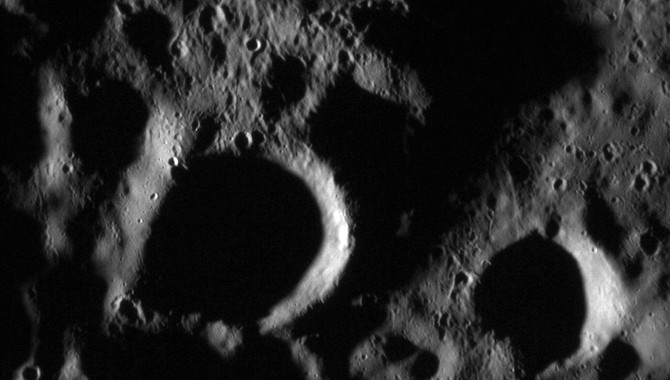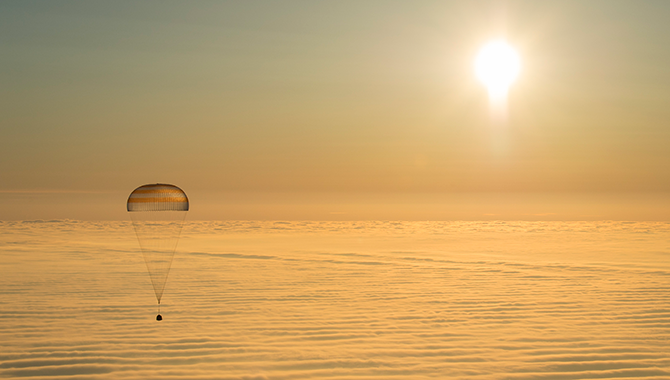
One of the final images to be sent back from MESSENGER, this April 16 image depicts the ejecta blanket of a newly formed impact crater. MESSENGER has sent back more than 250,000 images over the course of its mission.
Photo Credit: NASA/Johns Hopkins University Applied Physics Laboratory/Carnegie Institution of Washington
NASA’s Mercury orbiter is completely out of fuel. But that hasn’t stopped it from returning groundbreaking data about the innermost planet.
The propellant tanks on MErcury Surface, Space ENvironment, GEochemistery, and Ranging (MESSENGER) are dry. By all rights, the spacecraft should have succumbed to the pressure of the sun’s gravity and crashed onto the planet’s surface already. But engineering innovation has kept the mission alive far longer than expected.
Getting MESSENGER to Mercury required innovative thinking from the start. Sending a spacecraft into orbit around the planet closest to the sun was challenging in many ways: fuel demands, vehicle mass, and temperature extremes stood in the way of success. For instance, although the spacecraft weighed only 1100 kilograms (kg) at launch, more than half of that—600 kg—needed to be propellant.
“We had to be innovative in coming up with our design to minimize the mass. One example is our propellant tanks: they’re made of an ultra thin titanium that’s anywhere from half a millimeter to a millimeter in thickness,” said Helene Winters, MESSENGER project manager, at a recent celebration of MESSENGER’s accomplishments. “We also had to limit our power because power requirements translate pretty directly into additional mass. So our entire payload operates, at peak, off about 90 watts of power. All the science observations…across all the instruments operate on about the same power as a standard household light bulb.”
Despite carrying 600 kg of fuel, the MESSENGER mission still needed to conserve propellant. So they conceived of a 7.9 billion-kilometer trajectory—which included a flyby of Earth, two flybys of Venus, and three of Mercury—that would position the spacecraft correctly while decreasing its speed enough to successfully enter the planet’s orbit six and a half years after launch.
“[A] unique thing about this trajectory is MESSENGER is actually a flyby mission and an orbiter mission all in one,” said Daniel O’Shaughnessy, MESSENGER systems engineer. “The flybys offer a unique perspective of the planet because you’re in locations that you can’t observe the planet from when you’re in Mercury orbit.”
Orbital views, on the other hand, are extremely valuable because they provide the opportunity to study the planet in depth. But they present enormous challenges, too. Because MESSENGER flies so close to the sun, extreme heat is a major concern. So engineers designed a lightweight, ceramic cloth sunshade to protect the scientific instruments from the thermal environment of the sun.
“MESSENGER uses an intricate dance of orientation changes to help balance the heating across the various surfaces of the spacecraft to keep all of our sensitive electronics below their peak operating temperatures,” said O’Shaughnessy. But the spacecraft also carries heaters because temperatures plummet when it travels behind the planet.
In another fuel conservation success story, MESSENGER was the first spacecraft to successfully demonstrate solar sailing in orbit. It leveraged the pressure produced by solar radiation, which exerts a small but persistent force, to steer the spacecraft without resorting to the use of thrusters. Tactics such as this enabled MESSENGER to compete its original mission and then continue gathering groundbreaking scientific data for several more years.
“That’s just absolute genius to be able to use these techniques to benefit the mission and, more so, the science. And that makes MESSENGER particularly special for us to understand, learn about, and then apply to our next missions,” said Jim Green, director of NASA’s Planetary Science Division.
On April 6, the spacecraft’s fuel ran out entirely and the team was forced to innovate again. “Rather than giving in and succumbing to the forces of solar gravity, we’re able to rely on the onboard helium gas which we normally use to pressurize our propellant tanks. We’re able to push that out the thrusters and boost the spacecraft speed by another 20 miles per hour, allowing us to live yet another month—through the month of April,” said O’Shaughnessy.
MESSENGER is now flying a novel trajectory that brings it closer to the surface of the planet than ever before.
“There are some things, such as crustal magnetism, that we might be able to observe at very low altitudes that we couldn’t see at higher altitudes. So in this period of time we’re executing a series of maneuvers in rapid succession to keep us in this tight, low altitude band at closest approach,” said Winters. “At the end of this month, we will lose our battle with solar gravity and we’ll come in at 3.9 kilometers a second, which is about 8,700 miles per hour.” MESSENGER will conclude its mission by impacting the surface of the planet, probably on April 30.
Even without its final weeks of low altitude observations, MESSENGER has provided information that will continue to engage scientists after the mission has ended. In particular, findings from MESSENGER have helped inform understanding of how the planets in the inner solar system were constructed.
“[T]he ideas for how the inner planets got assembled, and how the building blocks of planetary materials were delivered to the inner solar system and survived the process of planetary accretion, are all being changed by MESSENGER’s results,” said Sean Solomon, MESSENGER principal investigator.
Perhaps the most interesting discovery, he said, are the deposits of water ice found at the planet’s poles. “Mercury therefore preserves a record of some very interesting processes in solar system history, and those polar regions are calling out to people like Jim Green and saying, ‘Send us another spacecraft! We have more stories to tell!’”
Johns Grunsfeld, Associate Administrator for the Science Mission Directorate, summed up the feelings of all of those involved. “NASA’s mission is to explore, discover, and inspire, and I can think of no better example than the MESSENGER spacecraft.” Data from the mission is expected to provide fodder for scientific discovery for decades to come.
MESSENGER was built and operated for NASA by the Johns Hopkins University Applied Physics Laboratory in Laurel, MD.
Read about MESSENGER’s top scientific and engineering innovations.
Learn more about MESSENGER’s trajectories and mission design.









